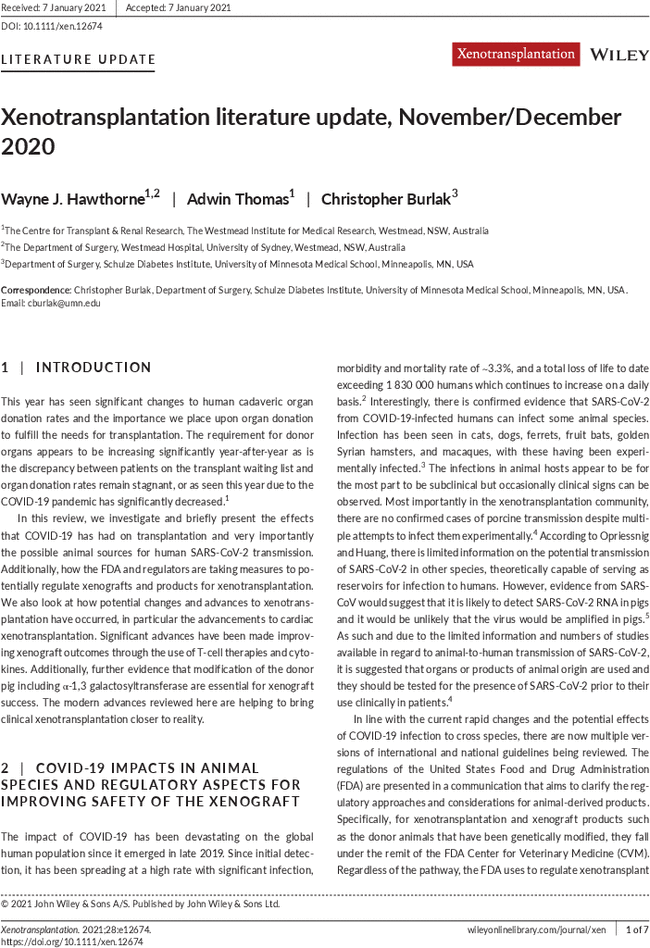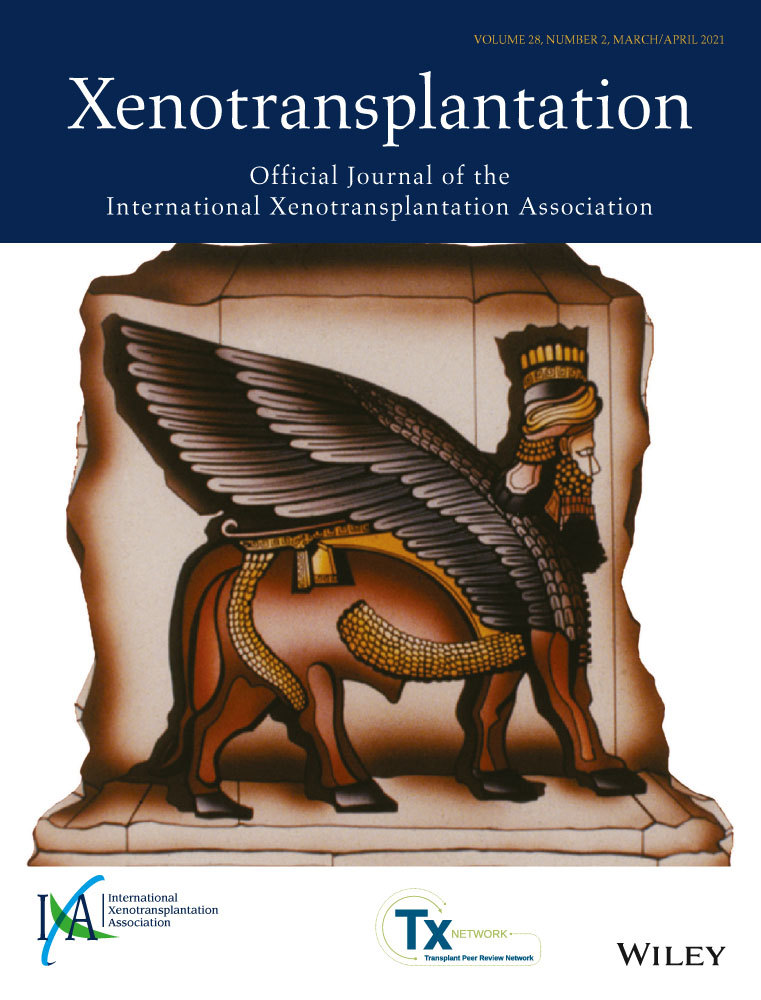Xenotransplantation literature update, November/December 2020
Wayne J. Hawthorne
The Centre for Transplant & Renal Research, The Westmead Institute for Medical Research, Westmead, NSW, Australia
The Department of Surgery, Westmead Hospital, University of Sydney, Westmead, NSW, Australia
Search for more papers by this authorAdwin Thomas
The Centre for Transplant & Renal Research, The Westmead Institute for Medical Research, Westmead, NSW, Australia
Search for more papers by this authorCorresponding Author
Christopher Burlak
Department of Surgery, Schulze Diabetes Institute, University of Minnesota Medical School, Minneapolis, MN, USA
Correspondence
Christopher Burlak, Department of Surgery, Schulze Diabetes Institute, University of Minnesota Medical School, Minneapolis, MN, USA.
Email: [email protected]
Search for more papers by this authorWayne J. Hawthorne
The Centre for Transplant & Renal Research, The Westmead Institute for Medical Research, Westmead, NSW, Australia
The Department of Surgery, Westmead Hospital, University of Sydney, Westmead, NSW, Australia
Search for more papers by this authorAdwin Thomas
The Centre for Transplant & Renal Research, The Westmead Institute for Medical Research, Westmead, NSW, Australia
Search for more papers by this authorCorresponding Author
Christopher Burlak
Department of Surgery, Schulze Diabetes Institute, University of Minnesota Medical School, Minneapolis, MN, USA
Correspondence
Christopher Burlak, Department of Surgery, Schulze Diabetes Institute, University of Minnesota Medical School, Minneapolis, MN, USA.
Email: [email protected]
Search for more papers by this author
REFERENCES
- 1Manara AR, Mumford L, Callaghan CJ, Ravanan R, Gardiner D. Donation and transplantation activity in the UK during the COVID-19 lockdown. Lancet. 2020; 396(10249): 465-466.
- 2 Data OWi. Country-by-country data on COVID-19 deaths. 2021; https://ourworldindata.org/covid-deaths#what-is-the-total-number-of-confirmed-deaths. Accessed May 01, 2021.
- 3Cleary SJ, Pitchford SC, Amison RT, et al. Animal models of mechanisms of SARS-CoV-2 infection and COVID-19 pathology. Br J Pharmacol. 2020; 177(21): 4851-4865.
- 4Opriessnig T, Huang YW. Further information on possible animal sources for human COVID-19. Xenotransplantation. 2020; 27(6):e12651.
- 5Opriessnig T, Huang YW. Coronavirus disease 2019 (COVID-19) outbreak: could pigs be vectors for human infections? Xenotransplantation. 2020; 27(2):e12591.
- 6Arcidiacono J. US Food and Drug Administration regulatory approaches for xenotransplantation products and xenografts. Xenotransplantation. 2020; 27(6):e12626.
- 7Fishman JA. Prevention of infection in xenotransplantation: Designated pathogen-free swine in the safety equation. Xenotransplantation. 2020; 27(3):e12595.
- 8Reichart B, Langin M. On the way (my way) to clinical xenogeneic heart transplantation. Presented at the 15th biannual IXA meeting, Munich, October 11, 2019. Xenotransplantation. 2020; 27(6):e12637.
- 9Schmoeckel M, Nollert G, Shahmohammadi M, et al. Prevention of hyperacute rejection by human decay accelerating factor in xenogeneic perfused working hearts. Transplantation. 1996; 62(6): 729-734.
- 10McGregor CG, Davies WR, Oi K, et al. Cardiac xenotransplantation: recent preclinical progress with 3-month median survival. J Thorac Cardiovasc Surg. 2005; 130(3): 844-851.
- 11Mohiuddin MM, Singh AK, Corcoran PC, et al. Chimeric 2C10R4 anti-CD40 antibody therapy is critical for long-term survival of GTKO.hCD46.hTBM pig-to-primate cardiac xenograft. Nat Commun. 2016; 7: 11138.
- 12Griesemer A, Yamada K, Sykes M. Xenotransplantation: immunological hurdles and progress toward tolerance. Immunol Rev. 2014; 258(1): 241-258.
- 13Romano M, Fanelli G, Albany CJ, Giganti G, Lombardi G. Past, present, and future of regulatory T Cell therapy in transplantation and autoimmunity. Front Immunol. 2019; 10: 43.
- 14Roemhild A, Otto NM, Moll G, et al. Regulatory T cells for minimising immune suppression in kidney transplantation: phase I/IIa clinical trial. BMJ. 2020; 371: m3734.
- 15Zhao Y, Hu W, Chen P, et al. Immunosuppressive and metabolic agents that influence allo- and xenograft survival by in vivo expansion of T regulatory cells. Xenotransplantation. 2020; 27(6):e12640.
- 16Malek TR, Castro I. Interleukin-2 receptor signaling: at the interface between tolerance and immunity. Immunity. 2010; 33(2): 153-165.
- 17Wang X, Wang W, Xu J, Wu S, Le Q. All-trans retinoid acid promotes allogeneic corneal graft survival in mice by regulating Treg-Th17 balance in the presence of TGF-beta. BMC Immunol. 2015; 16: 17.
- 18Fu S, Zhang N, Yopp AC, et al. TGF-beta induces Foxp3 + T-regulatory cells from CD4 + CD25 - precursors. Am J Transplant. 2004; 4(10): 1614-1627.
- 19Scheipers P, Reiser H. Role of the CTLA-4 receptor in T cell activation and immunity. Physiologic function of the CTLA-4 receptor. Immunol Res. 1998; 18(2): 103-115.
- 20Ippoliti G, D'Armini AM, Lucioni M, Marjieh M, Vigano M. Introduction to the use of belatacept: a fusion protein for the prevention of posttransplant kidney rejection. Biologics. 2012; 6: 355-362.
- 21Fischer A, Manske K, Seissler J, et al. Cytokine-inducible promoters to drive dynamic transgene expression: The “Smart Graft” strategy. Xenotransplantation. 2020; 27(6):e12634.
- 22Park JY, Park MR, Kwon DN, et al. Alpha 1,3-galactosyltransferase deficiency in pigs increases sialyltransferase activities that potentially raise non-gal xenoantigenicity. J Biomed Biotechnol. 2011; 2011: 560850.
- 23Ahn KS, Kim YJ, Kim M, et al. Resurrection of an alpha-1,3-galactosyltransferase gene-targeted miniature pig by recloning using postmortem ear skin fibroblasts. Theriogenology. 2011; 75(5): 933-939.
- 24Holzer PW, Chang E, Wicks J, Scobie L, Crossan C, Monroy R. Immunological response in cynomolgus macaques to porcine alpha-1,3 galactosyltransferase knockout viable skin xenotransplants-A pre-clinical study. Xenotransplantation. 2020; 27(6):e12632.
- 25Carel JC, Sheehan KC, Schreiber RD, Lacy PE. Prevention of rejection of transforming growth factor beta-treated rat-to-mouse islet xenografts by monoclonal antibody to tumor necrosis factor. Transplantation. 1993; 55(2): 456-458.
- 26Zhao Y, Cooper DKC, Wang H, et al. Potential pathological role of pro-inflammatory cytokines (IL-6, TNF-alpha, and IL-17) in xenotransplantation. Xenotransplantation. 2019; 26(3):e12502.
- 27Bradley JR. TNF-mediated inflammatory disease. J Pathol. 2008; 214(2): 149-160.
- 28Faustman DL, Davis M. TNF receptor 2 and disease: autoimmunity and regenerative medicine. Front Immunol. 2013; 4: 478.
- 29Costa C, Bell NK, Stabel TJ, Fodor WL. Use of porcine tumor necrosis factor receptor 1-Ig fusion protein to prolong xenograft survival. Xenotransplantation. 2004; 11(6): 491-502.
- 30Gao H, Liu L, Zhao Y, et al. Human IL-6, IL-17, IL-1beta, and TNF-alpha differently regulate the expression of pro-inflammatory related genes, tissue factor, and swine leukocyte antigen class I in porcine aortic endothelial cells. Xenotransplantation. 2017; 24(2). https://doi.org/10.1111/xen.12291
- 31Diller R, Winde G, Kotting S, Senninger N, Dietl KH, Spiegel HU. sTNF-RII: is it useful for the early diagnosis of rejection and for prognosis after renal transplantation? Transpl Int. 2002; 15(7): 335-340.
- 32Galili U. Natural anti-carbohydrate antibodies contributing to evolutionary survival of primates in viral epidemics? Glycobiology. 2016; 26(11): 1140-1150.
- 33Tector AJ, Mosser M, Tector M, Bach JM. The possible role of anti-Neu5Gc as an obstacle in xenotransplantation. Front Immunol. 2020; 11: 622.
- 34Oyelaran O, McShane LM, Dodd L, Gildersleeve JC. Profiling human serum antibodies with a carbohydrate antigen microarray. J Proteome Res. 2009; 8(9): 4301-4310.
- 35Burlak C, Taylor RT, Wang ZY, Tector AJ. Human anti-alpha-fucose antibodies are xenoreactive toward GGTA1/CMAH knockout pigs. Xenotransplantation. 2020; 27(6):e12629.
- 36Wang W, Yeung KWK. Bone grafts and biomaterials substitutes for bone defect repair: a review. Bioact Mater. 2017; 2(4): 224-247.
- 37Gashtasbi F, Hasannia S, Hasannia S, Mahdi Dehghan M, Sarkarat F, Shali A. Comparative study of impact of animal source on physical, structural, and biological properties of bone xenograft. Xenotransplantation. 2020; 27(6):e12628.
- 38Lee JS, Shin HK, Yun JH, Cho KS. Randomized clinical trial of maxillary sinus grafting using deproteinized porcine and bovine bone mineral. Clin Implant Dent Relat Res. 2017; 19(1): 140-150.
- 39Shibuya N, Jupiter DC. Bone graft substitute: allograft and xenograft. Clin Podiatr Med Surg. 2015; 32(1): 21-34.
- 40Wang F, Zhao L, Li H, et al. Scleral defect repair using decellularized porcine sclera in a rabbit model. Xenotransplantation. 2020; 27(6):e12633.
- 41Dailey RA, Marx DP, Ahn ES. Porcine dermal collagen in lower eyelid retraction repair. Ophthalmic Plast Reconstr Surg. 2015; 31(3): 233-241.
- 42Seyler TM, Bracey DN, Plate JF, et al. The development of a xenograft-derived scaffold for tendon and ligament reconstruction using a decellularization and oxidation protocol. Arthroscopy. 2017; 33(2): 374-386.
- 43Zheng J, Huang X, Zhang Y, et al. Short-term results of acellular porcine corneal stroma keratoplasty for herpes simplex keratitis. Xenotransplantation. 2019; 26(4):e12509.
- 44Thomas A, Hawthorne WJ, Burlak C. Xenotransplantation literature update, November/December 2019. Xenotransplantation. 2020; 27(1):e12582.
- 45Matsumoto S, Wynyard S, Giovannangelo M, et al. Long-term follow-up for the microbiological safety of clinical microencapsulated neonatal porcine islet transplantation. Xenotransplantation. 2020; 27(6):e12631.
- 46Wynyard S, Nathu D, Garkavenko O, Denner J, Elliott R. Microbiological safety of the first clinical pig islet xenotransplantation trial in New Zealand. Xenotransplantation. 2014; 21(4): 309-323.




